Abstract
The role of cytokines in gram-positive infections is still relatively poorly defined. The purpose of this study was to establish whether or not intact staphylococci and purified peptidoglycans and peptidoglycan components derived from staphylococci are capable of stimulating the release of tumor necrosis factor (TNF) by human monocytes. We show here that intact staphylococci and purified peptidoglycans, isolated from three Staphylococcus epidermidis and three S. aureus strains, were indeed able to induce secretion of TNF by human monocytes in a concentration-dependent fashion. TNF release was detected by both enzyme immunoassay and the L929 fibroblast bioassay. In the enzyme immunoassay, a minimal concentration of peptidoglycan of 1 micrograms/ml was required to detect TNF release by monocytes, whereas in the bioassay a peptidoglycan concentration of 10 micrograms/ml was needed to detect a similar amount of TNF release. Peptidoglycan components such as the stem peptide, tetra- and pentaglycine, and muramyl dipeptide were unable to induce TNF release from human monocytes.
Full text
PDF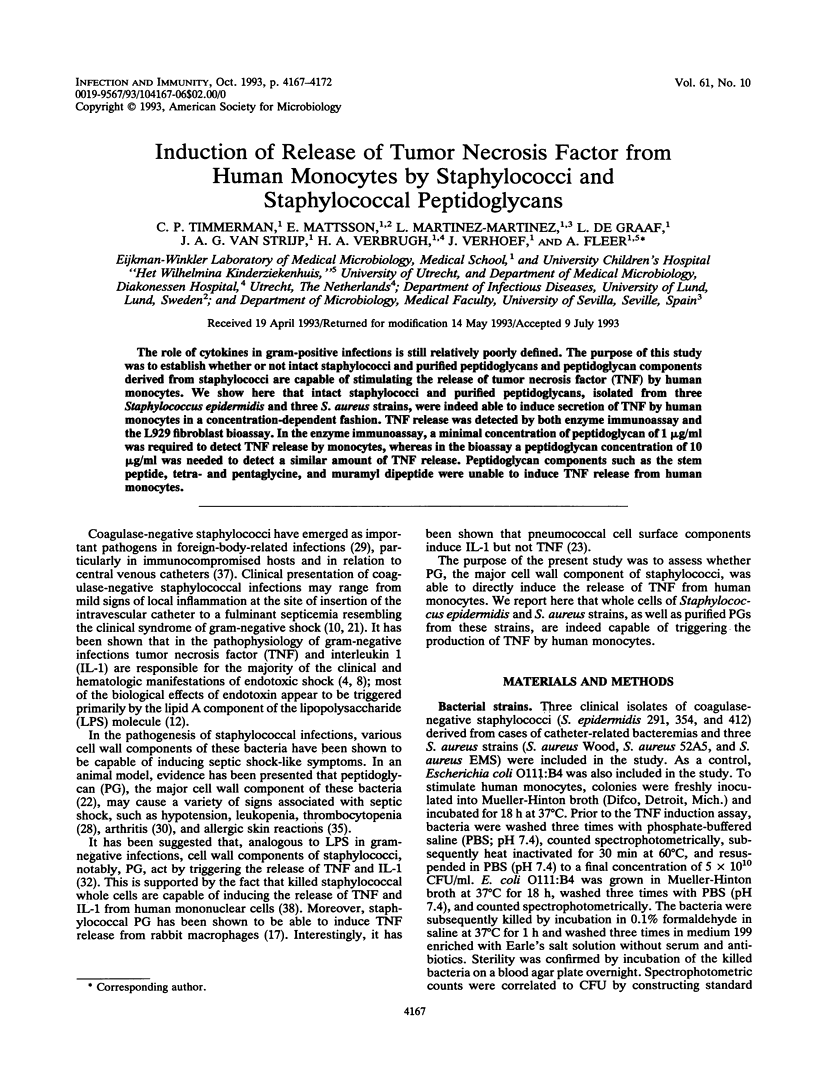
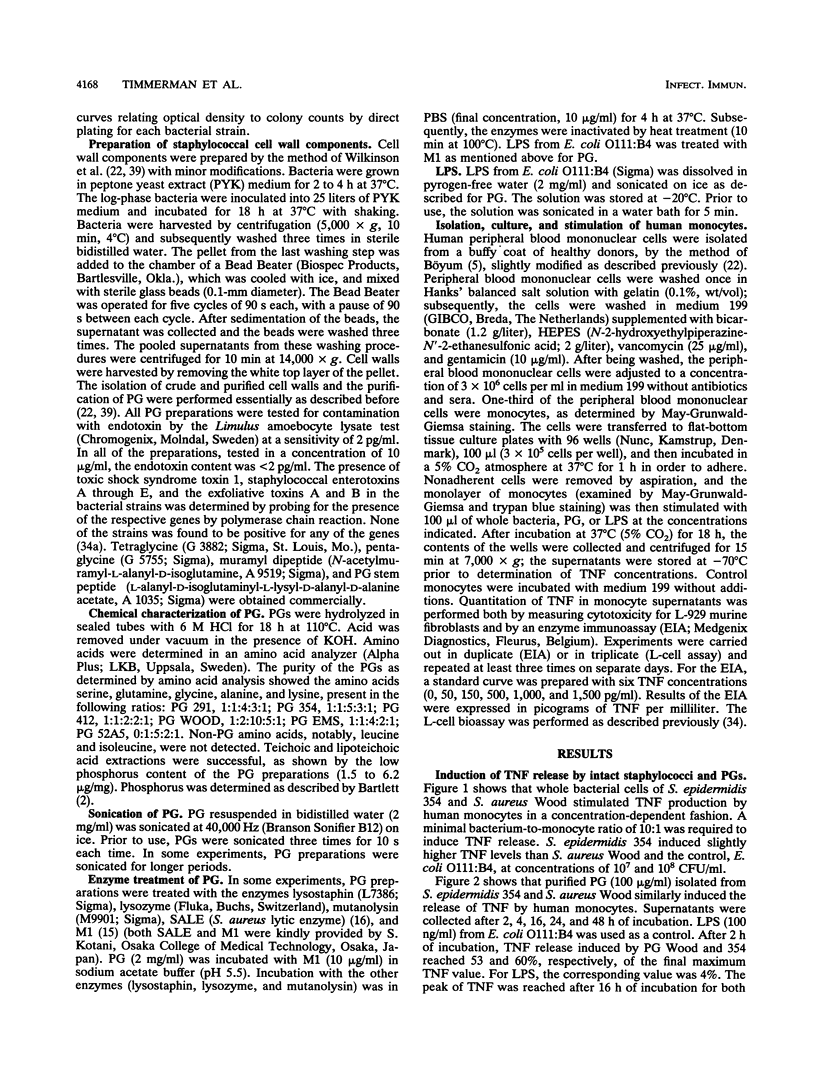
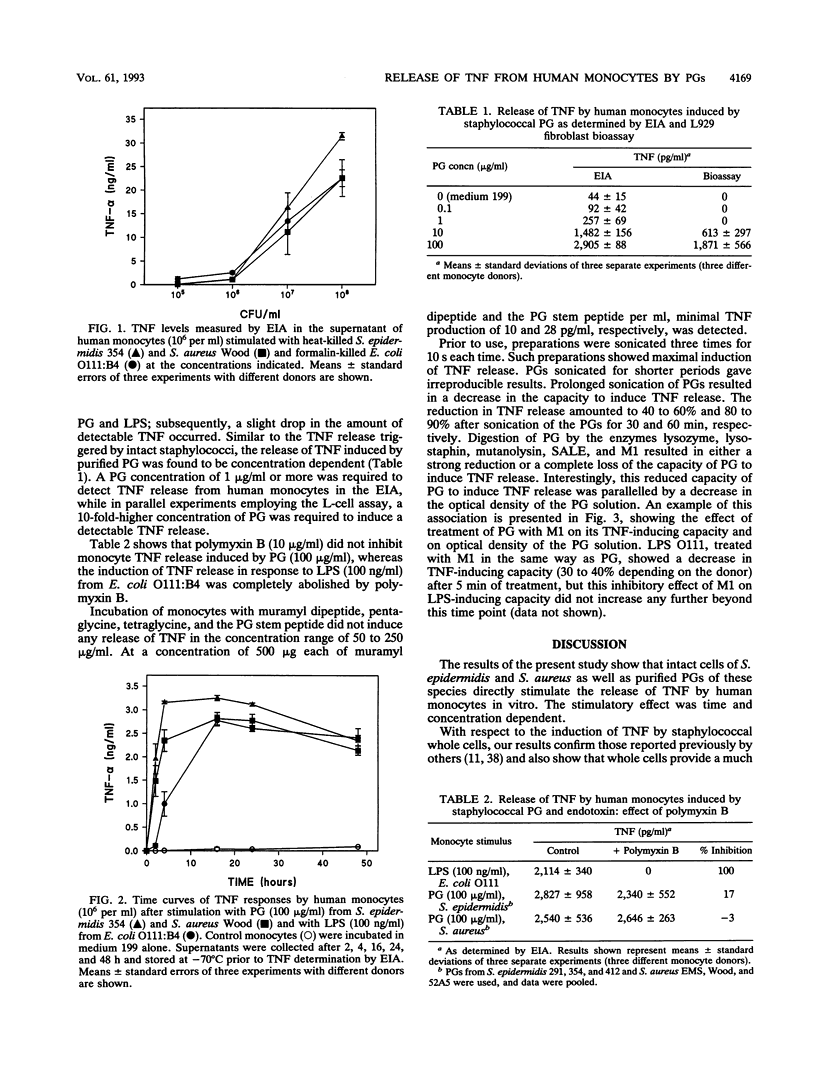
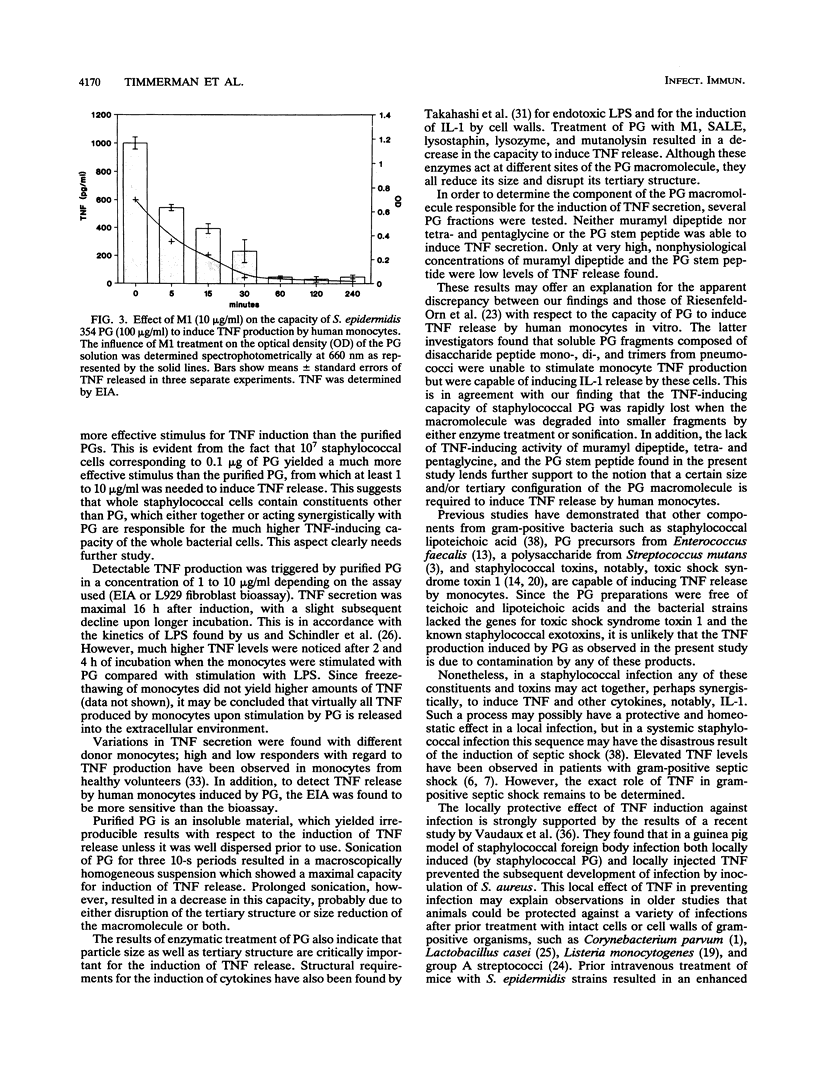
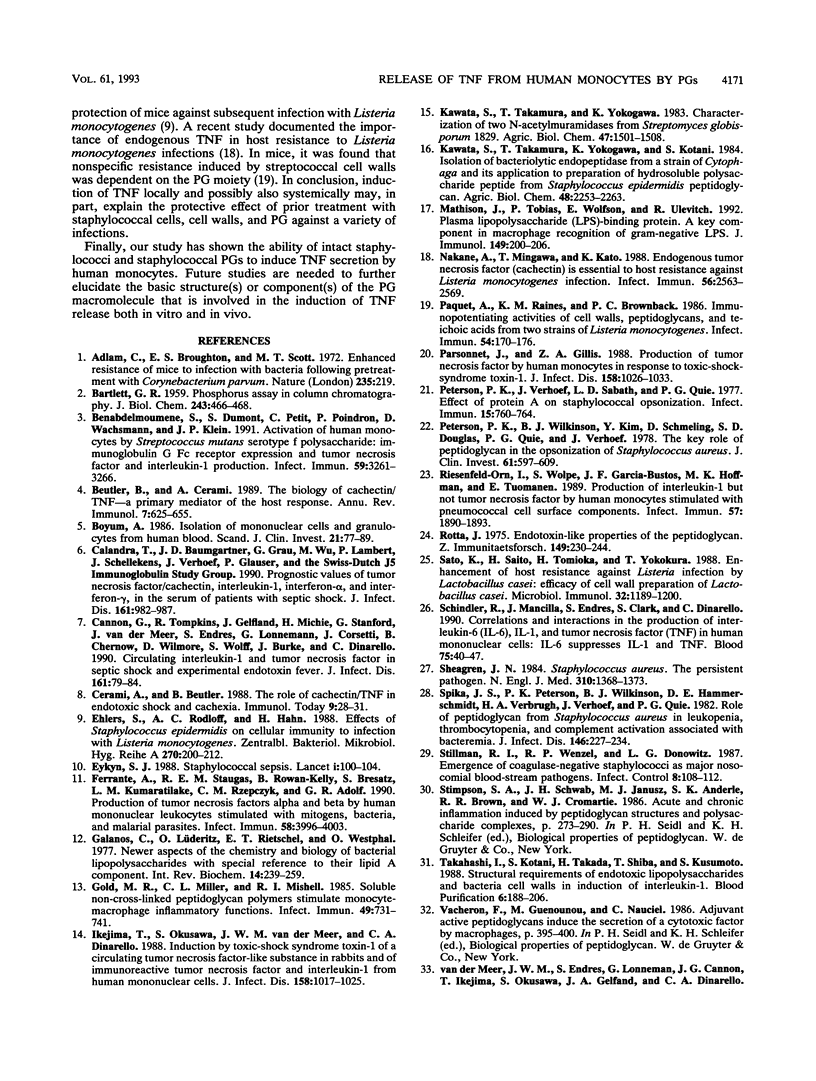
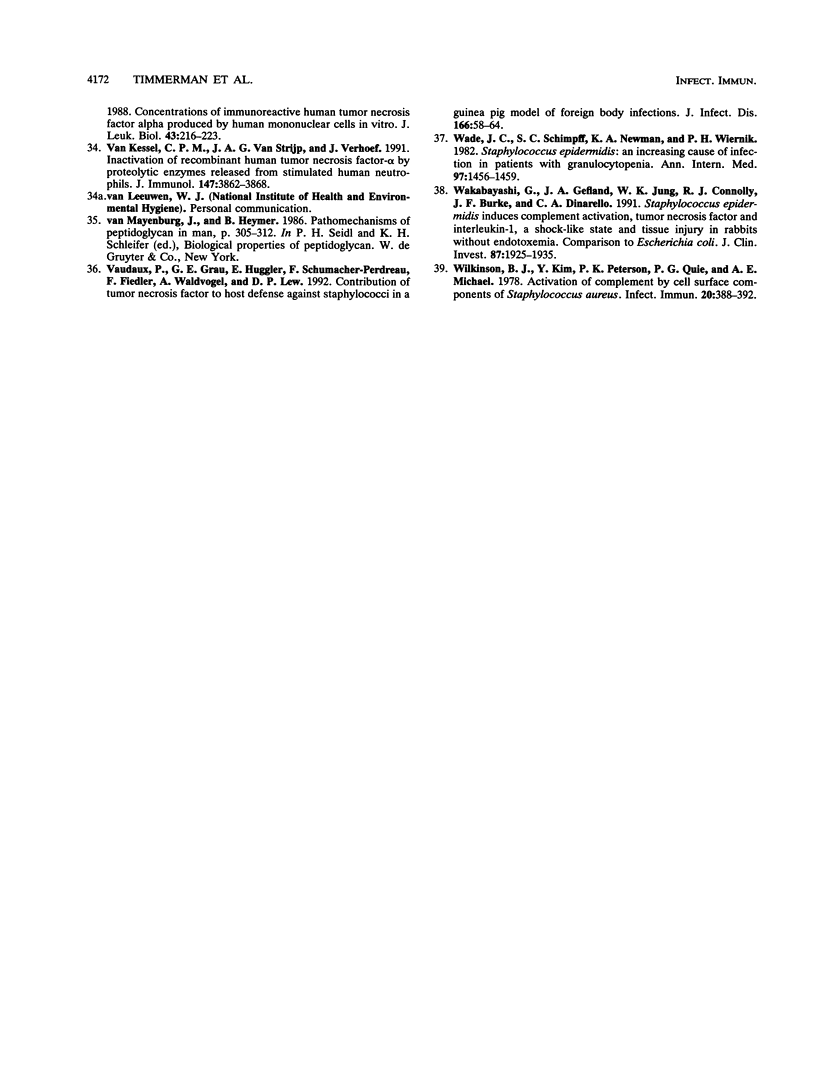
Selected References
These references are in PubMed. This may not be the complete list of references from this article.
- Adlam C., Broughton E. S., Scott M. T. Enhanced resistance of mice to infection with bacteria following pre-treatment with Corynebacterium parvum. Nat New Biol. 1972 Feb 16;235(59):219–220. doi: 10.1038/newbio235219a0. [DOI] [PubMed] [Google Scholar]
- BARTLETT G. R. Phosphorus assay in column chromatography. J Biol Chem. 1959 Mar;234(3):466–468. [PubMed] [Google Scholar]
- Benabdelmoumene S., Dumont S., Petit C., Poindron P., Wachsmann D., Klein J. P. Activation of human monocytes by Streptococcus mutans serotype f polysaccharide: immunoglobulin G Fc receptor expression and tumor necrosis factor and interleukin-1 production. Infect Immun. 1991 Sep;59(9):3261–3266. doi: 10.1128/iai.59.9.3261-3266.1991. [DOI] [PMC free article] [PubMed] [Google Scholar]
- Beutler B., Cerami A. The biology of cachectin/TNF--a primary mediator of the host response. Annu Rev Immunol. 1989;7:625–655. doi: 10.1146/annurev.iy.07.040189.003205. [DOI] [PubMed] [Google Scholar]
- Calandra T., Baumgartner J. D., Grau G. E., Wu M. M., Lambert P. H., Schellekens J., Verhoef J., Glauser M. P. Prognostic values of tumor necrosis factor/cachectin, interleukin-1, interferon-alpha, and interferon-gamma in the serum of patients with septic shock. Swiss-Dutch J5 Immunoglobulin Study Group. J Infect Dis. 1990 May;161(5):982–987. doi: 10.1093/infdis/161.5.982. [DOI] [PubMed] [Google Scholar]
- Cannon J. G., Tompkins R. G., Gelfand J. A., Michie H. R., Stanford G. G., van der Meer J. W., Endres S., Lonnemann G., Corsetti J., Chernow B. Circulating interleukin-1 and tumor necrosis factor in septic shock and experimental endotoxin fever. J Infect Dis. 1990 Jan;161(1):79–84. doi: 10.1093/infdis/161.1.79. [DOI] [PubMed] [Google Scholar]
- Cerami A., Beutler B. The role of cachectin/TNF in endotoxic shock and cachexia. Immunol Today. 1988 Jan;9(1):28–31. doi: 10.1016/0167-5699(88)91353-9. [DOI] [PubMed] [Google Scholar]
- Ehlers S., Rodloff A. C., Hahn H. Effects of Staphylococcus epidermidis on cellular immunity to infection with Listeria monocytogenes. Zentralbl Bakteriol Mikrobiol Hyg A. 1988 Nov;270(1-2):200–212. doi: 10.1016/s0176-6724(88)80155-x. [DOI] [PubMed] [Google Scholar]
- Eykyn S. J. Staphylococcal sepsis. The changing pattern of disease and therapy. Lancet. 1988 Jan 16;1(8577):100–104. doi: 10.1016/s0140-6736(88)90294-2. [DOI] [PubMed] [Google Scholar]
- Ferrante A., Staugas R. E., Rowan-Kelly B., Bresatz S., Kumaratilake L. M., Rzepczyk C. M., Adolf G. R. Production of tumor necrosis factors alpha and beta by human mononuclear leukocytes stimulated with mitogens, bacteria, and malarial parasites. Infect Immun. 1990 Dec;58(12):3996–4003. doi: 10.1128/iai.58.12.3996-4003.1990. [DOI] [PMC free article] [PubMed] [Google Scholar]
- Gold M. R., Miller C. L., Mishell R. I. Soluble non-cross-linked peptidoglycan polymers stimulate monocyte-macrophage inflammatory functions. Infect Immun. 1985 Sep;49(3):731–741. doi: 10.1128/iai.49.3.731-741.1985. [DOI] [PMC free article] [PubMed] [Google Scholar]
- Ikejima T., Okusawa S., van der Meer J. W., Dinarello C. A. Induction by toxic-shock-syndrome toxin-1 of a circulating tumor necrosis factor-like substance in rabbits and of immunoreactive tumor necrosis factor and interleukin-1 from human mononuclear cells. J Infect Dis. 1988 Nov;158(5):1017–1025. doi: 10.1093/infdis/158.5.1017. [DOI] [PubMed] [Google Scholar]
- Mathison J. C., Tobias P. S., Wolfson E., Ulevitch R. J. Plasma lipopolysaccharide (LPS)-binding protein. A key component in macrophage recognition of gram-negative LPS. J Immunol. 1992 Jul 1;149(1):200–206. [PubMed] [Google Scholar]
- Nakane A., Minagawa T., Kato K. Endogenous tumor necrosis factor (cachectin) is essential to host resistance against Listeria monocytogenes infection. Infect Immun. 1988 Oct;56(10):2563–2569. doi: 10.1128/iai.56.10.2563-2569.1988. [DOI] [PMC free article] [PubMed] [Google Scholar]
- Paquet A., Jr, Raines K. M., Brownback P. C. Immunopotentiating activities of cell walls, peptidoglycans, and teichoic acids from two strains of Listeria monocytogenes. Infect Immun. 1986 Oct;54(1):170–176. doi: 10.1128/iai.54.1.170-176.1986. [DOI] [PMC free article] [PubMed] [Google Scholar]
- Parsonnet J., Gillis Z. A. Production of tumor necrosis factor by human monocytes in response to toxic-shock-syndrome toxin-1. J Infect Dis. 1988 Nov;158(5):1026–1033. doi: 10.1093/infdis/158.5.1026. [DOI] [PubMed] [Google Scholar]
- Peterson P. K., Verhoef J., Sabath L. D., Quie P. G. Effect of protein A on staphylococcal opsonization. Infect Immun. 1977 Mar;15(3):760–764. doi: 10.1128/iai.15.3.760-764.1977. [DOI] [PMC free article] [PubMed] [Google Scholar]
- Peterson P. K., Wilkinson B. J., Kim Y., Schmeling D., Douglas S. D., Quie P. G., Verhoef J. The key role of peptidoglycan in the opsonization of Staphylococcus aureus. J Clin Invest. 1978 Mar;61(3):597–609. doi: 10.1172/JCI108971. [DOI] [PMC free article] [PubMed] [Google Scholar]
- Riesenfeld-Orn I., Wolpe S., Garcia-Bustos J. F., Hoffmann M. K., Tuomanen E. Production of interleukin-1 but not tumor necrosis factor by human monocytes stimulated with pneumococcal cell surface components. Infect Immun. 1989 Jul;57(7):1890–1893. doi: 10.1128/iai.57.7.1890-1893.1989. [DOI] [PMC free article] [PubMed] [Google Scholar]
- Rotta J. Endotoxin-like properties of the peptidoglycan. Z Immunitatsforsch Exp Klin Immunol. 1975 Jul;149(2-4):230–244. [PubMed] [Google Scholar]
- Sato K., Saito H., Tomioka H., Yokokura T. Enhancement of host resistance against Listeria infection by Lactobacillus casei: efficacy of cell wall preparation of Lactobacillus casei. Microbiol Immunol. 1988;32(12):1189–1200. doi: 10.1111/j.1348-0421.1988.tb01483.x. [DOI] [PubMed] [Google Scholar]
- Schindler R., Mancilla J., Endres S., Ghorbani R., Clark S. C., Dinarello C. A. Correlations and interactions in the production of interleukin-6 (IL-6), IL-1, and tumor necrosis factor (TNF) in human blood mononuclear cells: IL-6 suppresses IL-1 and TNF. Blood. 1990 Jan 1;75(1):40–47. [PubMed] [Google Scholar]
- Sheagren J. N. Staphylococcus aureus. The persistent pathogen (first of two parts). N Engl J Med. 1984 May 24;310(21):1368–1373. doi: 10.1056/NEJM198405243102107. [DOI] [PubMed] [Google Scholar]
- Spika J. S., Peterson P. K., Wilkinson B. J., Hammerschmidt D. E., Verbrugh H. A., Verhoef J., Quie P. G. Role of peptidoglycan from Staphylococcus aureus in leukopenia, thrombocytopenia, and complement activation associated with bacteremia. J Infect Dis. 1982 Aug;146(2):227–234. doi: 10.1093/infdis/146.2.227. [DOI] [PubMed] [Google Scholar]
- Stillman R. I., Wenzel R. P., Donowitz L. C. Emergence of coagulase negative staphylococci as major nosocomial bloodstream pathogens. Infect Control. 1987 Mar;8(3):108–112. doi: 10.1017/s0195941700067278. [DOI] [PubMed] [Google Scholar]
- Takahashi I., Kotani S., Takada H., Shiba T., Kusumoto S. Structural requirements of endotoxic lipopolysaccharides and bacterial cell walls in induction of interleukin-1. Blood Purif. 1988;6(3):188–206. doi: 10.1159/000169545. [DOI] [PubMed] [Google Scholar]
- Vaudaux P., Grau G. E., Huggler E., Schumacher-Perdreau F., Fiedler F., Waldvogel F. A., Lew D. P. Contribution of tumor necrosis factor to host defense against staphylococci in a guinea pig model of foreign body infections. J Infect Dis. 1992 Jul;166(1):58–64. doi: 10.1093/infdis/166.1.58. [DOI] [PubMed] [Google Scholar]
- Wakabayashi G., Gelfand J. A., Jung W. K., Connolly R. J., Burke J. F., Dinarello C. A. Staphylococcus epidermidis induces complement activation, tumor necrosis factor and interleukin-1, a shock-like state and tissue injury in rabbits without endotoxemia. Comparison to Escherichia coli. J Clin Invest. 1991 Jun;87(6):1925–1935. doi: 10.1172/JCI115218. [DOI] [PMC free article] [PubMed] [Google Scholar]
- Wilkinson B. J., Kim Y., Peterson P. K., Quie P. G., Michael A. F. Activation of complement by cell surface components of Staphylococcus aureus. Infect Immun. 1978 May;20(2):388–392. doi: 10.1128/iai.20.2.388-392.1978. [DOI] [PMC free article] [PubMed] [Google Scholar]
- van Kessel K. P., van Strijp J. A., Verhoef J. Inactivation of recombinant human tumor necrosis factor-alpha by proteolytic enzymes released from stimulated human neutrophils. J Immunol. 1991 Dec 1;147(11):3862–3868. [PubMed] [Google Scholar]


